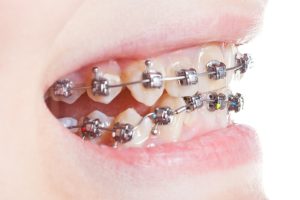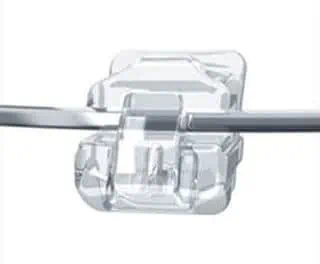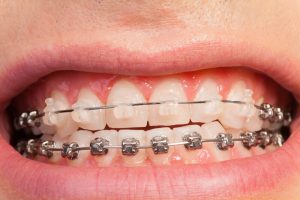There are a few different kinds of braces out there, and if you want straighter teeth it might be time to start looking at your options. Self-ligating braces are just one of those options, but how do you know if they are right for you?
Knowing which braces to choose can be difficult, especially when you take into consideration the different factors that can influence your choice.
Your orthodontics needs, budget, and lifestyle can all impact which braces are best for you so it's important to know more about your braces options.
If you think these braces may be a good choice for you then you probably have some questions, including:
- What are self-ligating braces?
- How much do they cost?
- Self-ligating braces vs traditional braces: What are the advantages and disadvantages?
- What are some alternatives to consider?
Keep reading to learn more about self-ligating braces, why you might want them, and their alternatives so that you can make an informed decision about your dental care.
We will refer to these braces as Damon braces as well since that's the most popular brand name.
In This Article
What are self-ligating braces?
Self-ligating braces are braces that consist of metal brackets and wire, just like traditional metal braces. The metal brackets are made in such a way that they do not need the help of elastic bands or ‘o' ties to hold the wire in place. So, to better understand what they are, let's discuss traditional fixed braces first.


Traditional metal braces
Fixed metal braces are generally a combination of 3 different parts:
- Metal brackets
- Archwires
- Elastic bands, ‘o' ties, or ligatures
When you get traditional braces, your dentist will cement a metal bracket to each tooth. The metal brackets are then connected by metal wire and secured in place by small rubber bands which are also known as ‘o' ties.
The wire is the flexible and adjustable part of your braces that puts pressure on your teeth to move them into the desired position.
Small rubber bands are then placed around the metal brackets to hold the wire in place, enabling it to do its job aligning your teeth. You can decide which color these ‘o' ties are; some people opt for bright colors to jazz up their look.
What is the difference between self-ligating braces and traditional braces?
Now that you know how traditional braces work, it is simple to understand how self-ligating braces are different. While both types of braces look like traditional train tracks, they have one very important difference that we mentioned earlier.
Self-ligating brackets don't need rubber bands to secure the wire because the metal brackets clip the wire securely in place. Another notable point is that with modern technology, some archwires are heat activated, meaning that as the mouth warms them up they tighten. This means they can add continuous pressure to encourage them into the desired position.
The following table summarises the similarities and differences between these braces.
Self-ligating braces | Traditional braces | |
Comfort | More comfortable than metal braces. Fewer adjustments needed. | Can be uncomfortable, especially after each adjustment. |
Appearance | Less visible. Clear or ceramic options available. | Visible metal train tracks. |
Hygiene | Easier to clean due to the lack of rubber bands. Fewer parts for plaque to build up around. | More effort required to maintain oral hygiene. |
Treatment time | Slightly shorter than that of metal braces. | 6 to 24 months or more depending on case complexity. |
Effectiveness | Predictable tooth movements and more effective results than in conventional orthodontics. | Good results. |
Additionally, some studies find that Damon braces are more efficient than traditional braces, but all in all, both methods are very successful.
Self-ligating brackets
Self-ligating brackets are different from regular metal brackets because they have a built-in sliding door mechanism that enables them to secure the wire. They need no outside assistance from ‘o' ties, therefore cutting out the tedious step of putting on and removing rubber bands at every appointment.


How do self-ligating braces work?
Like traditional braces, self-ligating braces still require your dentist or orthodontist to attach brackets to the outside of your teeth. The difference is that these brackets have spring-loaded clips that secure the archwire instead of ‘o' ties.
The process of getting your braces on should be shorter than that of regular braces since your dentist won't have to secure the archwire with rubber bands.
The same goes for any follow-up appointments where rubber bands need to be removed and then put back on afterward. However, the clip mechanism on self-ligating brackets should open and close as easily as shutting a door, reducing appointment times!
How long do they take?
The timeframe for traditional metal braces can be anywhere from 6 to 24 months or more. How long you have your braces on depends entirely on the severity of your orthodontic case.
If you have a mild to moderate case, you could be looking at a shorter treatment time, and if you have more complex problems, you will have to wear your braces longer.
Braces with a self-ligating system might have a shorter treatment time due to their efficiency and predictability. This is because the elastic bands on regular braces wear out over time and cannot maintain pressure like the spring-loaded clips braces that self-ligate.
And, because the clips don't wear out and can maintain pressure, patients need fewer dental appointments.
Advantages and disadvantages
As we have already mentioned, the main advantage of self-ligating braces is the fact that ‘o' ties are not needed, making the whole process more efficient. Shorter and fewer dental appointments is definitely a bonus, but are there any other benefits of self-ligating braces, and do they have any disadvantages?
What are the benefits of self-ligating braces?
These braces can treat the same complexity of orthodontic cases as traditional braces. But, they use modern progressive technology to make your treatment faster and more comfortable. Some of the benefits of self-ligating braces include:
- They are easier to brush as there are fewer parts and places for plaque to build up
- The treatment is quicker
- There is less friction on the teeth, and damage to the enamel
- Shorter treatment time
- Fewer dental appointments
- Option of transparent or tooth-colored brackets if you are concerned about your appearance
- Heat-activated archwires
What are the potential downsides?
Self-ligating braces are a level up from traditional fixed braces, but there are downsides. The main downside to these braces is the price. They are more expensive than regular metal braces and, they might not be available on Medicaid or other state-funded health insurance plans. Some other downsides include:
- Soreness and irritation of the cheeks, gums, and lips
- They are visible even if you get the clear or ceramic brackets
What are the different types of self-ligating braces?


As you may remember, we briefly touched on the fact that they can come with metal, clear or ceramic brackets. Brands such as Damon self-ligating braces do both types of braces, giving you the choice.
Metal self-ligating braces
Metal self-ligating braces look just like traditional braces, in fact, you can even decorate them with colored bands. However, in this case, the bands are purely decoration and you still get the other benefits of having them.
Ceramic self-ligating braces
Self-ligating clear braces or white braces, also known as self-ligating ceramic braces are less visible for those who are concerned about how they would look with a mouth full of metal. They are not invisible though, so if you are concerned about your appearance you may want to read up about Invisalign and check whether you are eligible.
The brackets on ceramic self-ligating braces are slightly more comfortable than metal brackets because they are slightly smaller and rounder at the edges which can help reduce irritation to your gums and cheeks.
However, it doesn't eliminate pain from braces altogether as any teeth straightening treatment that moves your teeth will cause discomfort and even pain at times. To learn more about braces pain, read our article that answers the question: Why do braces hurt?
What do self-ligating braces cost?
Self-ligating braces can cost between $3,500 – $8,500 depending on the complexity of the orthodontic treatment. These braces are more expensive than regular braces and are not available on Medicaid.
If you are looking for less visible braces, it might be worth looking at clear aligners such as Invisalign as they can cost less and may have a shorter treatment time. And, because they are removable they are an effective way to straighten teeth without braces if you are eligible for treatment with them.
Conclusion


Self-ligating braces are very similar looking to regular braces, but they are more comfortable and have a shorter treatment time. This is due to the progressive technology of the spring-loaded clips that connect and secure the archwire to the brackets.
The clip mechanism on the brackets ensures faster treatment because they do not wear out and loosen over time like rubber bands. And, because the dentist doesn't have to remove rubber bands from the brackets, appointments are much shorter as well.
Heat-activated self-tightening wires also help to make things more comfortable and ensure fewer uncomfortable dentist visits to adjust your braces.
Self-ligating braces come in both metal and ceramic options which means that those who are concerned about their appearance can choose a less visible option. However, it's worth looking into clear aligners like Invisalign if you want invisible braces.
NIH: Comparison of self-ligating Damon3 and conventional MBT brackets regarding alignment efficiency and pain experience: A randomized clinical trial. Consulted 14th September 2022.




